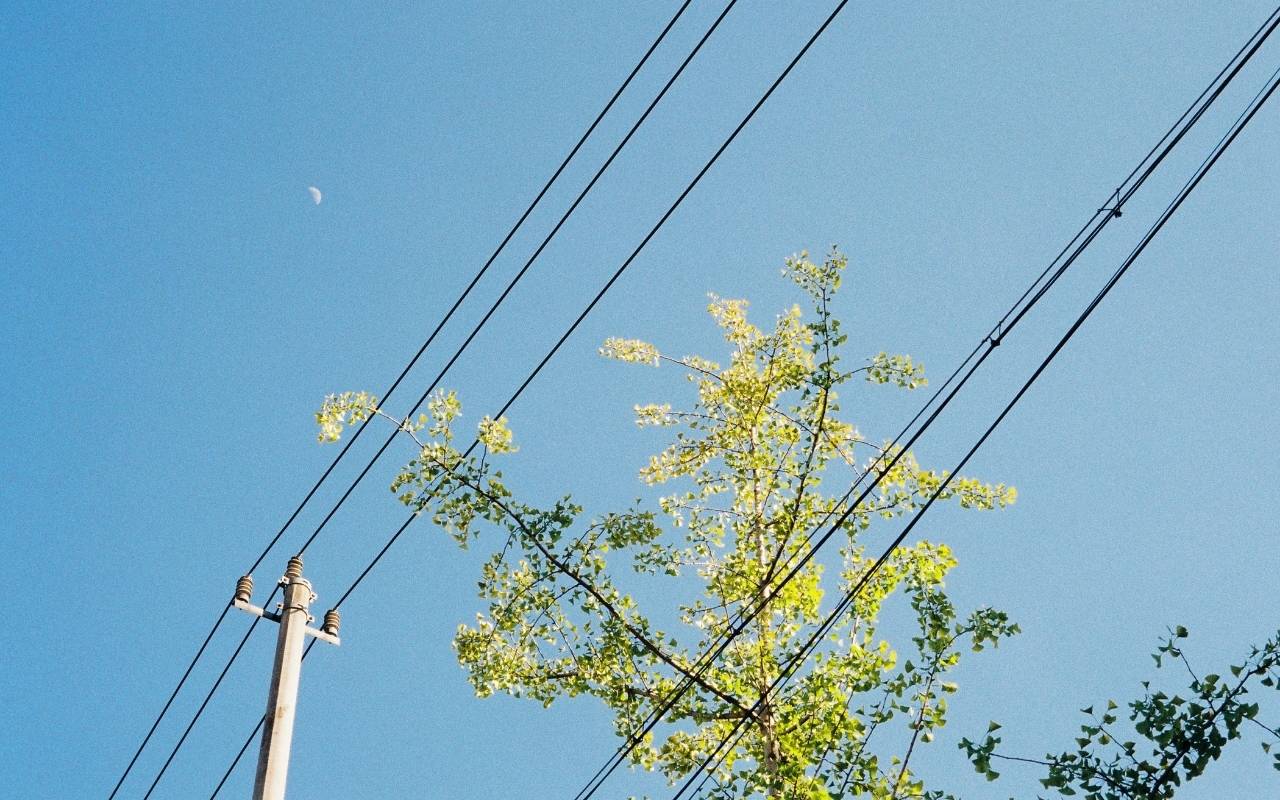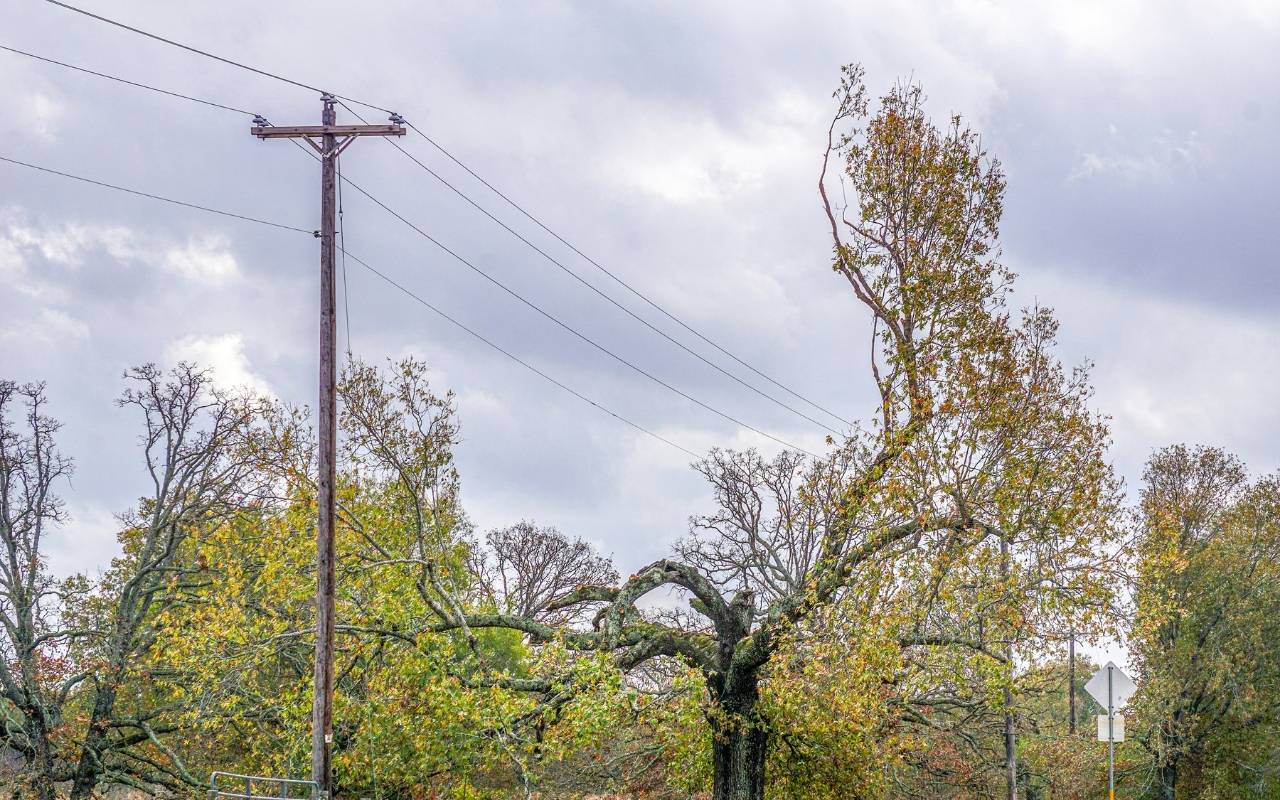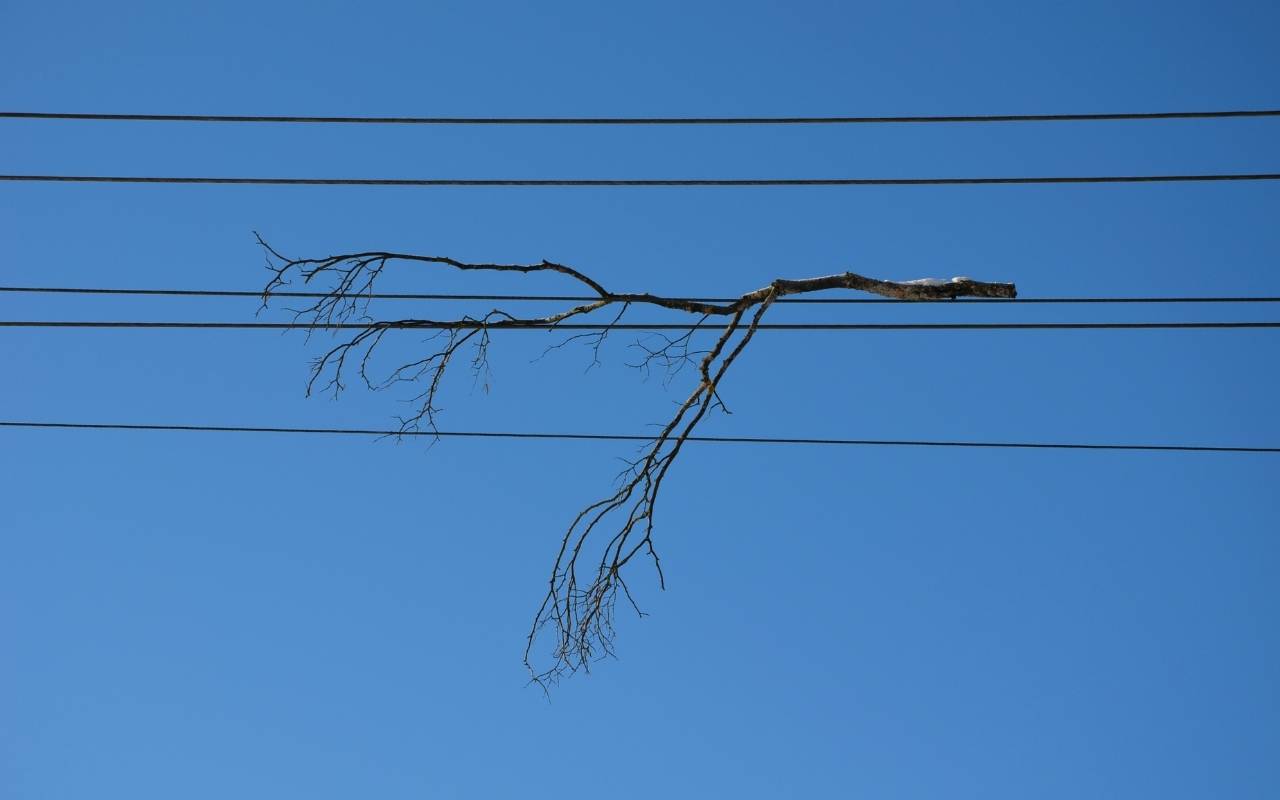It seems like every month we see another news story about a homeowner injured or electrocuted while trimming trees near power lines. The sad thing is that it’s entirely preventable. With a little knowledge about working around tree branches that are touching or near power lines, the accidents wouldn’t have happened.
In this article, we answer all of your questions about trees growing near electric utility lines, including:
- Whether trees near power lines are dangerous
- What happens when a tree branch touches a power line
- If you can (or should) prune trees growing near the electric service line to your own house
- Who’s responsible for trimming trees near or touching primary and secondary power lines
- Whether electricity kills trees
- What you can and cannot plant beneath and near power lines (we share some great shrub and tree ideas for northern Virginia)
- And much more!
Trimming Trees Near Power Lines
Let’s start by talking about trimming trees near overhead electrical wires.
It’s tempting to try to trim your own trees and large shrubs. After all, you just need a ladder and a pruning saw, right? (Wrong, actually – there’s a lot more to it than that!)
It’s dangerous enough when a homeowner tries to DIY this kind of work. But when those trees or shrubs are near power lines, including the service line from the pole or street to the home, the risks increase exponentially.
Many homeowners who try to prune trees near overhead electrical wires underestimate the potential danger. Horrific accidents can happen when a homeowner uses long-handled cutting tools and/or metal ladders to trim backyard trees and shrubs. Too often, they don’t notice an energized overhead wire and end up hitting it with their pruning tools, resulting in injury or even death.
Here are just two recent examples of homeowners injured while pruning trees near power lines:
- A man was shocked and seriously injured after contacting a high-voltage power line with a pole saw while trimming his trees. He sustained severe burns to his hands and feet, with exit wounds on both feet, and was airlifted to a nearby hospital. The man lost his right hand as a result of the injuries.
- A homeowner climbed a ladder to trim a tree branch that was dropping leaves into his swimming pool and causing a nuisance. The branch came in contact with the power line, shocking the man with a jolt of electricity and sending him into cardiac arrest. He fell 20 feet to the ground but was revived by medics at the scene.
These are not freak accidents – they happen far too often.
Hopefully, the FAQs below will help prevent at least some of these tragic outcomes.
FAQs About Trees & Power Lines
Are tree branches touching power lines dangerous?
Trees that grow too close to electric lines are a hazard. They can cause power outages or momentary power interruptions when branches touch overhead lines. Electrical arcing and sparking from a wire to a nearby branch can cause fires. And if you’re standing too near the tree, electricity can jump from the tree to you, causing serious injuries or even death.
Never climb or prune a tree that’s touching an electrical wire, whether it’s a major utility line or the service line to your house. And teach children to never climb or play around trees near power lines. Tree limbs can easily make accidental contact with electric wires while climbing or playing around the tree, often with fatal results can. Even if branches aren’t touching a power line, a child’s weight could bend a branch to the point that it makes contact with the power line.
Why is it dangerous? Does electricity really travel through trees?
A live tree can conduct electricity; a dead tree generally does not (unless it’s wet, such as during a rainstorm). The water in a living tree’s tissues is a good conductor of electricity, allowing it to travel from the branches to the ground. Electricity travels through a tree more easily if the tree is wet.

What happens when a tree branch touches a power line?
When any part of a tree is electrified, the current passes through the tree’s tissues and into the ground. Similar to what happens with a lightning strike, the electricity superheats any moisture in the tree. Steam and boiling sap can erupt from the tree, taking bark, wood, and branches with it.
Anything that’s touching the tree and the ground (like a person) will also act as a conductor. Energy will flow through the object or person, with similar outcomes as the tree.
Is it still dangerous if the tree branch isn’t actually touching the power line?
Yes! If branches are near the power line, electricity can arc from the power line to the tree. This doesn’t typically happen under normal conditions but is possible if there’s a voltage surge on the power line, such as from a nearby lightning strike.
Arcing can cause a fire and the electricity can kill anyone in or near the tree.
It’s also possible that a branch will unexpectedly touch the electrical lines, perhaps due to a wind gust or if it’s being pruned.
And any pruning tools you may be using, such as a long-handled pruning saw or a ladder, can accidentally come in contact with the power lines.
Can power lines kill trees?
The electricity running through a power line won’t directly kill nearby trees. But if branches come in contact with the lines, or if electricity arcs from a power line, the tree can catch on fire.
Can you trim a tree that’s touching a power line?
Unless you plan on getting electrocuted, you should NOT touch, let alone prune a tree that’s in contact with power lines! Just touching a branch that’s touching a wire can cause a fatal injury. The voltage on a typical overhead power line can be a hundred times greater than your indoor household current – and many of us know first-hand that getting shocked with only 120 volts isn’t fun!
According to Federal Regulations, you must stay at least 10 feet away when working near power lines. This ensures you won’t accidentally make contact with live wires.
What about tree branches touching the electrical service line (secondary line) to my house – can I prune those?
Don’t be fooled by the voltage of the lines. You may think that working on the trees or shrubs near your home’s service line is safer than working near the high voltage secondary distribution lines on the pole by the street, but that’s simply not true.
Service wires leading from the pole to the house can pack a punch. The type of shock you might have received (and survived) when changing a household light switch is not the same type of shock you will receive if you contact a low-voltage utility wire. A common house switch carries 120 volts but the electric flow is usually limited to 10, 15 or 20 amps. A common “house drop” (service wire) contains 240 volts and up to 20 amps or more.
Given the right set of circumstances, even the shock you might get from a common light switch can kill. Thankfully, it’s fairly easy to break electrical contact while standing inside a house. But if you’re up a ladder or in a tree, it may be more difficult to break contact with the energized wire. This means that the service line over a typical yard could easily kill you.
OK, so what if the tree is near but not touching the service line?
We don’t recommend working on any trees within 10 feet of an electrical line. It’s always best to call in a professional tree service company to prune or trim trees near wires.
But if you must, here are a few tips to avoid trees in or near wires:
- Look for power lines before pruning trees and large shrubs. If lines are anywhere near the tree, do NOT attempt any tree work. Professional tree climbers have the training and equipment needed to perform these tasks safely.
- Never climb a tree in order to prune it. Even if the wires aren’t currently touching the tree, the tree’s branches will shift once you begin climbing or removing limbs, putting them (and you!) in contact with the power lines.
- Wearing rubber-soled shoes or rubber gloves while tree pruning will NOT protect you from a fatal shock if you, your tools, or the tree, make contact with electrical wires.
- Never extend long-handled saws or pruners into a tree without checking for power lines. It’s easy to miss seeing them in a leafy tree canopy!
- Electricity is always trying to go somewhere, and it will easily travel through metal, water, trees, and/or the ground.
- Don’t move ladders or long-handled pruning tools around the yard without first looking up. It’s easy to get your tools snagged on overhead electrical or utility wires.
- Keep all ladders and other tools in the SAFE ZONE, at least 10 feet from any power lines. Always make sure that, if the ladder fell, it would not contact any power lines or other electrical equipment.
- Remember that tree branches near high-voltage power lines can conduct electricity. Never lean your ladder against a tree or tree branch that is in contact with or near a power line.

What if I need to trim trees or do other work near primary utility power lines?
If you want to trim or prune any trees or vegetation growing near power lines, you (or your tree service company) must request assistance from Dominion to remove or prune trees that are close to their lines. Do not do this yourself! Approaching power lines is not only deadly, it’s against the law (the VA High Voltage Safety Act).
Who is responsible for trimming trees near power lines?
If a tree or limb is touching a power line, call Dominion so they can evaluate whether it should be removed. If a limb has fallen onto a line, call Dominion to remove it. For safety, do not attempt to remove any trees or tree limbs from power lines yourself!
If you’re wondering exactly what can happen if you touch a power line, please view this video: What can a 7,200-volt power line do?
When should you call the utility company about trees near power lines?
Don’t wait until your tree is tangled up in wires. Call the utility company if:
- Branches of a fast-growing tree are getting near the power lines
- Any part of a tree is touching the wires, including broken branches
- A broken branch is stuck or hanging from the power line
- Vines have grown from your tree to the nearby power line
When in doubt, call Dominion: For your safety, never attempt to trim any plants or trees that are touching or growing near power lines.
- Call Dominion at 866-366-4357, and also refer to their Tree Trimming Brochure
How close can tree branches be to power lines before it becomes a problem?
The right distance between a tree and a power line depends on the height of the lines and the mature size of the tree.
However, there are a few rules of thumb and guidelines to follow –
Don’t plant a tree directly beneath a power line
That may seem obvious, but many people do it anyway. If you’ve ever seen a tree pruned to grow around electrical wires, you’ll know that the outcome isn’t a happy one. Plus, there’s the risk of power outages when the tree or its branches contact the lines.
According to Dominion Virginia Power, which provides electricity to most of northern Virginia, you shouldn’t plant trees of any kind within 15 feet of electric utility wires. Instead, plant low-growing shrubs. Below are some of the varieties recommended for northern Virginia.
Recommended Shrubs to Plant Under Power Lines
- Abelia grandiflora – Glossy abelia
- Berberis juliannae – Wintergreen barberry
- Berberis thunbergi – Japanese barberry
- Buddeia Davidii – Butterfly bush
- Chaenomeles speciosa – Flowering quince
- Cornus sericea – Redtwig osier dogwood
- Euonymous alatus ‘compacta’ – Dwarf winged euonymous
- Forsythia x intermedia – Forsythia
- Ilex crenata – Japanese holly
- Ilex glabra – Inkberry holly
- Juniperus chinensis ‘pfitzeriana’ – Pfitzer juniper
- Mahonia bealei -Leatherleaf mahonia
- Nandina domestica – Nandina
- Pinus mugo var. mugo – Dwarf mugo pine
- Viburnum x burkwoodii compat
- Spiraea prunifolia – Bridalwreath spirea
- Spiraea x vanhouttei -Vanhoutte spirea
- Viburnum x burkwoodii – Burkwood viburnum
- Viburnum carlesi – Korean spicebush
- Wiegela – Old fashioned weigela
Dominion Energy has a more complete list of shrubs recommended for planting beneath electrical utility lines.
Consider the tree’s mature height
Trees get larger than you might imagine when you plant them! That spindly “stick in the ground” can quickly grow to 30 feet or more. So read up on any tree you’re considering to find out how tall it will get – and then plant it in the right spot.
General planting guidelines for trees near utility wires
- Trees that reach 20 – 45 feet at maturity should be planted at least 15 – 35 feet away
- If the tree’s mature height is more than 45 feet, plant it at least 50 feet away from nearby lines
Note: If you plan to plant within a high voltage transmission line easement, you must first submit an encroachment request to Dominion Energy.

Are there any trees I can plant near power lines?
While you shouldn’t plant directly beneath electrical wires, you do have options for planting near them. Just be sure to consider the tree’s mature height and whether it will pose a safety risk down the road.
Learn more about utility-friendly trees here.
Deciduous Trees to Plant Near Power Lines
- Amur Maple (Acer tataricum sp. ginnala)
- Apple Serviceberry (Amelanchier x grandiflora)
- Eastern Redbud (Cercis canadensis)
- Smoke Tree (Cotinus obovatus)
- Dogwood (Cornus sp.) – includes Kousa, Cornelian Cherry, and Pagoda Dogwood
- Magnolia (Magnolia sp.) – Large-Flowered and Star Magnolia
- Japanese Tree Lilac (Syringa reticulata)
- Dwarf Crabapple (Malus sp.)
- American Hornbeam (Carpinus caroliniana)
- Chokecherry (Prunus virginiana)
- Snow Fountain Cherry (Prunus snofozam)
- Hawthorn (Crataegus sp.) – Winter King Hawthorn, Washington Hawthorn, and Cockspur Hawthorn
Small or Dwarf Evergreens
- Arborvitae (Thuja occidentalis)
- Dwarf Upright Juniper (Juniperus sp.)
- Dwarf Spruce (Picea sp.)
- Dwarf Pine (Pinus sp.)
If in doubt, get professional help choosing the trees for your yard that won’t grow to interfere with the electricity supply. We’re happy to help you choose trees that provide shade, fall color, spring blossoms, and more.
Fairfax County also has some helpful guidelines for planting near power lines.
And, of course, don’t forget to call 811 before digging a large planting hole. The underground utility locator service will mark the location of any underground utilities, so accidental contact, damage, and injuries can be avoided.
The Bottom Line
Look up before doing any work on your trees! Are there any wires in or near your trees? How close are they? Can you do the work without any risk of contacting an energized wire?
There are so many things that can go wrong for do-it-yourselfers trying to trim tree branches. For example, many homeowners aren’t aware of proper tree pruning techniques and don’t understand the physics and mechanics of pruning. Done incorrectly, the cut branch can swing in an unpredictable direction as it falls and could easily land on an energized wire.
If your tree branches are near power lines of any kind, your best option is to hire an insured tree care professional with the experience, expertise, and equipment to safely take down or prune trees in wires. Require proof of liability insurance. And, if the work is due to storm damage, check to see if the cost of the work is covered by your insurance company.
Important Safety Note: Always assume downed lines and any nearby objects are energized and dangerous. If you see fallen lines on your property or in roadways, stay away and contact Dominion Energy (or your local utility) immediately.
Get helpful tips, local news, inspiring stories, and more delivered right to your inbox every month. Don't miss another issue - join today!




